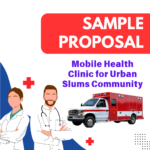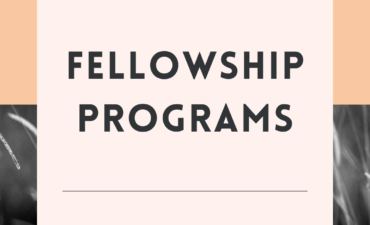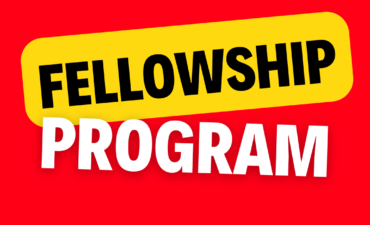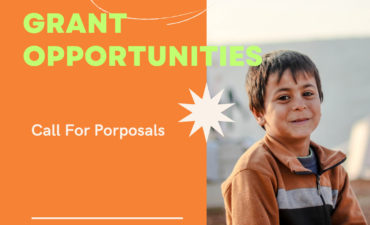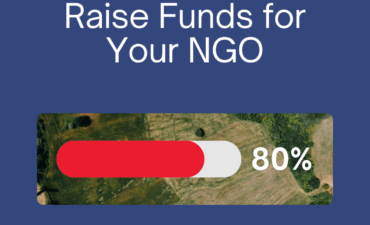Introduction: Sample Proposal for NGOs Mobile Health Clinic for Urban Slums Community. In the heart of bustling urban landscapes lie communities often overlooked—urban slums, where access to basic healthcare remains a significant challenge. Recognizing the critical need for accessible and quality healthcare services in these underserved areas, we propose the establishment of a Mobile Health Clinic specifically designed to serve the urban slum community. This initiative aims to bridge the gap between these communities and essential healthcare services, ensuring that individuals and families living in urban slums receive the care they deserve.
Drawing inspiration from successful models such as the Community Health of Central Washington’s Mobile Medical Clinic, our proposal envisions a fully equipped mobile health unit capable of providing a wide range of primary care services, health screenings, and educational programs tailored to the unique needs of urban slum dwellers. The mobile clinic will be designed with attention to detail, incorporating feedback from community members and healthcare professionals to ensure it meets the specific health challenges faced by these communities.
Key features of the proposed Mobile Health Clinic include:
- Accessibility: Strategically scheduled visits to various urban slum locations, ensuring regular and reliable access to healthcare services.
- Comprehensive Care: Offering a broad spectrum of services, from routine check-ups and vaccinations to chronic disease management and health education.
- Cultural Sensitivity: Staff trained in cultural competency to effectively engage with diverse populations and build trust within the community.
- Collaboration: Partnering with local NGOs, community leaders, and government agencies to maximize impact and sustainability.
By leveraging innovative solutions and community partnerships, the Mobile Health Clinic for Urban Slums Community seeks to transform healthcare accessibility and outcomes for some of the most vulnerable populations in our cities. Together, we can create healthier communities and a brighter future for all.
Background Information about the Urban Slum Community
Urban slums are densely populated informal settlements characterized by substandard housing, inadequate access to basic services such as water and sanitation, and insecure tenure. These communities often lack proper infrastructure, leading to poor living conditions that exacerbate health issues. Over 55% of the world’s population lives in urban areas, a figure expected to rise to 68% by 2050, indicating a growing concern for urban health, especially in slum areas where almost 40% of urban dwellers have no access to safely managed sanitation services and many lack access to adequate drinking water.
Overview of Health Issues Faced by the Community
Urban slum communities face a triple threat of public health concerns: rising non-communicable diseases, persistent threats of infectious disease outbreaks, and increased risk of violence and injuries. Non-communicable diseases are exacerbated by poorly designed urban transport systems, air and noise pollution, and barriers to safe physical activity. Infectious diseases thrive in these environments due to poor sanitation, overcrowding, and unhealthy housing conditions. Diseases like COVID-19, tuberculosis, dengue, and diarrhoea are prevalent, fueled by poor urban waste management and lack of clean sanitation services.
Moreover, health inequities are stark in urban areas, often varying significantly even from street to street. Migrants and disadvantaged groups tend to live in the most deprived neighborhoods with limited access to health services, leading to below-average health outcomes. The COVID-19 pandemic has further highlighted these disparities, with cases and deaths in deprived areas doubling those in more advantaged areas due to overcrowding, lack of clean sanitation services, and high exposure to the virus.
Importance of Addressing These Health Issues
Addressing the health issues faced by urban slum communities is crucial for several reasons:
- Reducing Health Inequities: Tackling the root causes of poor health in slums helps reduce health inequities, ensuring fairer distribution of health resources and outcomes across populations.
- Preventing Disease Outbreaks: Improving living conditions and access to healthcare can prevent infectious disease outbreaks, protecting not just slum dwellers but also the wider urban population.
- Enhancing Quality of Life: Better health outcomes lead to improved quality of life, enabling individuals to work, study, and participate fully in community life.
- Sustainable Urban Development: Addressing health issues in slums contributes to sustainable urban development goals by creating healthier, more resilient communities.
- Climate Change Mitigation: Urban populations are vulnerable to climate change effects. Improving urban health, especially in slums, can mitigate these risks by enhancing resilience against heatwaves, floods, and other climate-related hazards 3.
In conclusion, addressing the health issues faced by urban slum communities is essential for achieving equitable health outcomes, preventing disease outbreaks, improving quality of life, contributing to sustainable urban development, and mitigating climate change impacts.
Detailed Description of the Health Problems in Urban Slums
Urban slums are characterized by densely packed settlements with inadequate provision of essential services and infrastructure, including sanitation, water, electricity, waste management, and security. These conditions expose residents to a myriad of health problems, ranging from infectious diseases due to poor sanitation and overcrowding, to higher rates of under nutrition leading to stunted growth and development among children. Additionally, the high transmission rate of infectious diseases in these areas is exacerbated by the lack of waste collection, water, and sanitation facilities. The health vulnerabilities of slum dwellers are further compounded by the neighborhood effects, where densely packed environments negatively impact residents’ health outcomes compared to those living in non-slum areas.
Statistics and Data to Support the Existence of These Problems
Globally, over 800 million people live in slum areas, yet very little is understood about their health vulnerabilities. Studies conducted by the African Population and Health Research Center (APHRC) have shown that child mortality rates are higher in slums than in non-slum urban areas and even rural regions. Residents of slums also experience higher rates of under nutrition compared to those from non-slum areas. Furthermore, the World Health Organization reports that almost 40% of urban dwellers lack access to safely managed sanitation services, and many do not have access to adequate drinking water. An estimated 91% of people in urban areas breathe polluted air, contributing to higher levels of non-communicable diseases and injuries.
Consequences of Not Addressing These Health Issues
Failure to address the health issues faced by urban slum communities can lead to severe consequences, including increased morbidity and mortality rates, perpetuation of poverty cycles, and exacerbation of social inequities. The continued growth of slums without corresponding improvements in living conditions and healthcare access can transform cities into epicenters of disease transmission, including vector-borne diseases. Moreover, the absence of effective interventions can result in a significant portion of the population living longer with disability or experiencing more years of life lost compared to non-slum residents. Addressing these issues is not only crucial for improving public health but also for achieving sustainable urban development goals and mitigating the impacts of climate change on vulnerable populations
Objectives (Sample Proposal for NGOs Mobile Health Clinic for Urban Slums Community)
Improve Access to Primary Healthcare
The objective to improve access to primary healthcare in urban slums is grounded in the understanding that primary healthcare serves as the foundation for a robust health system. It is the first point of contact for individuals seeking healthcare services and plays a pivotal role in managing health needs throughout a person’s life. By focusing on improving access, the aim is to ensure that all members of the urban slum community can easily reach healthcare services that are affordable, acceptable, and of high quality. This involves overcoming barriers such as geographical distance, financial constraints, and cultural or linguistic differences that might deter individuals from seeking care. Strategies to achieve this objective include establishing community-based health centers, deploying mobile clinics, and integrating technology to facilitate telemedicine consultations.
Provide Preventive Healthcare Services
Providing preventive healthcare services is crucial for reducing the burden of disease and promoting overall health and wellbeing within urban slum communities. Preventive care encompasses a wide range of services, including immunizations, screenings, health education, and lifestyle counseling aimed at preventing diseases before they occur. Given the high prevalence of communicable diseases and the challenges posed by inadequate sanitation and hygiene facilities in urban slums, preventive healthcare becomes even more critical. The objective here is to allocate resources towards preventive measures, despite the challenges faced by developing countries in prioritizing such services due to limited healthcare infrastructure and financial resources. Implementing preventive healthcare services can significantly reduce morbidity and mortality rates associated with preventable diseases, thereby improving the quality of life for urban slum dwellers.
Educate the Community on Health and Hygiene
Education on health and hygiene is essential for empowering individuals, families, and communities within urban slums to take charge of their own health. This objective focuses on raising awareness about the importance of preventive measures, promoting healthy behaviors, and providing information on how to access healthcare services. Community education initiatives can address the limited awareness and knowledge among residents regarding the significance of preventive care and equip them with the skills needed to maintain good health and hygiene practices. Such initiatives can also tackle skepticism about the effectiveness of preventive interventions and resistance to change, which are common barriers to the utilization of preventive services. By educating the community, the aim is to foster a culture of health consciousness and self-care, thereby reducing the demand for curative services and improving overall public health outcomes
Project Description (Sample Proposal for NGOs Mobile Health Clinic for Urban Slums Community)
Detailed Description of the Mobile Health Clinic
The Mobile Health Clinic is envisioned as a comprehensive healthcare delivery model designed to bring essential health services directly to the doorsteps of urban slum communities. Equipped with state-of-the-art medical equipment and staffed by a dedicated team of healthcare professionals, the clinic aims to address the immediate health needs of these underserved populations.
Type of Services Provided:
- Medical Check-ups: Regular health assessments to monitor the overall health status of individuals and identify potential health issues early.
- Vaccinations: Administration of vaccines against common communicable diseases to prevent outbreaks and protect vulnerable groups.
- Health Education: Provision of information and guidance on maintaining good health, hygiene practices, and disease prevention strategies tailored to the specific needs of urban slum dwellers.
Operational Details:
- Frequency of Visits: The clinic plans to visit each identified location bi-weekly, ensuring consistent access to healthcare services.
- Locations Covered: Target areas will be selected based on population density, current healthcare access levels, and identified health needs. Initially, the clinic will serve five urban slum communities, with plans to expand coverage based on the project’s success and available resources.
Implementation Plan
Phases of the Project:
- Preparation Phase (Months 1-3): This phase involves securing funding, purchasing the mobile clinic vehicle, procuring medical supplies and equipment, and hiring staff.
- Pilot Phase (Months 4-6): Initial rollout in one selected urban slum community to test operational efficiency and service delivery models.
- Expansion Phase (Months 7-12): Based on learning from the pilot phase, expand services to four additional urban slum communities.
- Evaluation and Scaling Phase (Month 13 onwards): Conduct comprehensive evaluations to measure impact and refine strategies for scaling up the project to reach more communities.
Timeline for Each Phase:
- Preparation Phase: January – March
- Pilot Phase: April – June
- Expansion Phase: July – December
- Evaluation and Scaling Phase: Ongoing from January of the following year
Staffing and Management
Qualifications and Roles of the Healthcare Team:
- Medical Doctors: Provide general medical consultations, manage chronic diseases, and oversee vaccinations.
- Nurses: Assist doctors, administer vaccines, and conduct health screenings.
- Health Educators: Deliver health education sessions, promote preventive care, and engage with community members.
- Driver/Maintenance Staff: Ensure the mobile clinic is operational and navigate to designated locations.
Management Structure:
The project will be managed by a Project Coordinator who oversees daily operations, ensures adherence to timelines, and manages stakeholder relations. A Medical Director will lead the healthcare team, focusing on clinical aspects and quality of care. An Administrative Officer will handle logistics, procurement, and financial management. Regular meetings between the management team and healthcare staff will facilitate communication and coordination, ensuring smooth project execution and continuous improvement based on feedback and evaluations.
Methodology (Sample Proposal for NGOs Mobile Health Clinic for Urban Slums Community)
The approach to delivering healthcare services through the Mobile Health Clinic is centered around bringing healthcare directly to the communities in need, thereby eliminating common barriers such as transportation, time constraints, and system complexity. This model is designed to meet people where they live, making healthcare accessible and convenient. Services will be comprehensive, covering medical consultations, vaccinations, and health education, ensuring a holistic approach to health and wellness. The clinic will operate on a schedule that maximizes accessibility, visiting each targeted urban slum community regularly to provide ongoing care and build trust within the community.
Strategies for Community Engagement
Community engagement is pivotal for the success of the Mobile Health Clinic. Strategies for engaging the community include:
- Community Meetings: Holding initial meetings with community leaders and residents to understand their health needs and concerns, and to introduce the Mobile Health Clinic concept.
- Local Partnerships: Collaborating with local NGOs, schools, and churches to disseminate information about the clinic’s services and schedules.
- Health Awareness Campaigns: Organizing health fairs and workshops to educate the community on various health topics, preventive care, and the importance of regular check-ups.
- Feedback Mechanisms: Establishing channels for community feedback to continuously improve the clinic’s services and address evolving health needs effectively Monitoring and Evaluation Methods.
Monitoring and evaluation are essential components of the project to assess its impact and effectiveness. Methods for monitoring and evaluation include:
- Patient Surveys: Conducting regular surveys among patients to gather feedback on the quality of care received satisfaction levels, and areas for improvement.
- Health Outcome Indicators: Tracking health outcome indicators such as vaccination rates, disease prevalence, and mortality rates within the served communities to measure the clinic’s impact on population health.
- Operational Metrics: Monitoring operational metrics such as the number of patients served, frequency of visits, and types of services utilized to assess the efficiency and reach of the Mobile Health Clinic.
- Qualitative Assessments: Implementing qualitative research methods, including interviews and focus groups, to gain deeper insights into the community’s perceptions of the clinic and its services.
By employing these methodologies, the Mobile Health Clinic aims not only to deliver essential healthcare services but also to foster a sense of ownership and partnership within the urban slum communities it serves. This comprehensive approach ensures that the project remains responsive to the community’s needs and contributes significantly to improving health outcomes among vulnerable populations.
Target Beneficiaries (Sample Proposal for NGOs Mobile Health Clinic for Urban Slums Community)
Description of the Target Population
The target population for the Mobile Health Clinic initiative comprises residents of urban slum communities within the city. These communities are characterized by high population densities, substandard living conditions, and limited access to basic services, including healthcare. The residents often include low-income families, migrant workers, and marginalized groups who face significant barriers to accessing quality healthcare services. Children, pregnant women, elderly individuals, and people with chronic illnesses within these communities are particularly vulnerable and thus constitute priority groups for the clinic’s services.
Criteria for Selecting Beneficiaries
Beneficiaries will be selected based on the following criteria:
- Residency: Individuals residing within the identified urban slum communities.
- Vulnerability: Priority will be given to vulnerable groups, including children under five, pregnant women, elderly persons (aged 60 and above), and individuals with chronic conditions.
- Access to Healthcare: Those with limited or no access to regular healthcare services due to financial constraints, distance, or other barriers.
- Need for Services: Individuals identified through initial health assessments and community surveys as having immediate health needs that can be addressed by the Mobile Health Clinic.
Estimated Number of Beneficiaries
Based on preliminary surveys and demographic data of the targeted urban slum communities, it is estimated that approximately 5,000 individuals will be direct beneficiaries of the Mobile Health Clinic services in the first year of operation. This estimate accounts for the initial five communities selected for the pilot phase, considering an average population density and the proportion of vulnerable groups within these areas. As the project expands to additional communities in subsequent phases, the number of beneficiaries is expected to increase significantly, aiming to reach an estimated 20,000 individuals by the end of the third year.
Budget (Sample Proposal for NGOs Mobile Health Clinic for Urban Slums Community)
Below is a sample budget table for operating a Mobile Health Clinic, including estimated costs for various categories. Please note that these figures are hypothetical and meant to serve as a guideline. Actual costs may vary based on location, scale of operations, and specific project requirements.
| Expense Category | Estimated Cost |
| Vehicle Purchase/Lease | $50,000 |
| Medical Equipment & Supplies | $30,000 |
| Fuel & Maintenance | $12,000/year |
| Staff Salaries | |
| – Medical Doctors | $60,000/year |
| – Nurses | $40,000/year |
| – Health Educators | $30,000/year |
| – Driver/Maintenance Staff | $24,000/year |
| Training & Development | $5,000/year |
| Community Engagement Activities | $10,000/year |
| Insurance | $7,500/year |
| Licenses & Permits | $2,000/year |
| Utilities (Internet, Phone) | $1,200/year |
| Office Supplies & Admin Costs | $3,000/year |
| Monitoring & Evaluation | $8,000/year |
| Contingency Fund | $10,000 |
| Total Estimated Cost |
Annual Operational Budget: $212,700
Initial Setup Costs (One-Time Expenses): $92,000
Grand Total (First Year Including Setup): $304,700
This budget outlines the primary expenses associated with establishing and operating a Mobile Health Clinic for one year, including both recurring operational costs and initial setup costs. It’s important to adjust these figures based on detailed research and planning specific to the target area and scope of services. Additionally, securing funding or donations for medical supplies and equipment can significantly reduce initial expenses.
Sustainability Plan (Sample Proposal for NGOs Mobile Health Clinic for Urban Slums Community)
Strategies for Ensuring the Long-Term Sustainability of the Project
To ensure the long-term sustainability of the Mobile Health Clinic project, several strategies will be implemented:
- Community Integration: Embedding the clinic within the community fabric through partnerships with local organizations, schools, and churches. This integration fosters a sense of ownership among community members and encourages long-term support.
- Diversified Funding Sources: Securing funding from a mix of sources including government grants, private donations, corporate sponsorships, and fundraising events. Diversification reduces dependency on a single source and mitigates financial risks.
- Capacity Building: Training local healthcare workers and volunteers to staff the clinic, thereby reducing operational costs and enhancing community involvement. This approach also ensures continuity of services even if external staff is unavailable.
- Innovative Service Delivery Models: Adopting patient-centered care models that focus on education, empowerment, and cultural competence. These models address barriers resulting from poor patient-provider communication and mistrust, leading to improved health outcomes and sustained engagement.
Plans for Securing Ongoing Funding
Securing ongoing funding is crucial for the sustainability of the Mobile Health Clinic. Strategies include:
- Grant Applications: Regularly applying for government and foundation grants focused on healthcare accessibility and community development.
- Corporate Partnerships: Establishing partnerships with corporations interested in social responsibility initiatives, offering them branding opportunities in exchange for financial support.
- Fundraising Events: Organizing community events, charity runs, and online crowd funding campaigns to raise funds from the public.
- Sustainability Fees: Implementing nominal fees for certain services, with provisions for those unable to pay, to generate revenue while maintaining accessibility.
Community Involvement and Ownership
Fostering community involvement and ownership is essential for the project’s sustainability. This will be achieved through:
- Community Advisory Boards: Establishing boards comprising community leaders and residents to guide the clinic’s operations and ensure services meet community needs.
- Volunteer Programs: Recruiting volunteers from within the community for various roles, including administrative support, health education, and outreach activities.
- Feedback Loops: Implementing mechanisms for regular feedback from community members on clinic services, allowing for continuous improvement based on community input.
By implementing these strategies, the Mobile Health Clinic aims to become a self-sustaining entity that not only provides essential healthcare services but also empowers the urban slum communities it serves, ensuring long-term impact and success.
In conclusion, the Mobile Health Clinic initiative stands as a beacon of hope for the urban slum communities, addressing a critical gap in healthcare accessibility and quality. By mobilizing healthcare services directly to where they are most needed, this project aims to transform the health landscape of these underserved areas, ensuring that no one is left behind in the pursuit of better health and a brighter future.
Through a comprehensive approach that combines cutting-edge medical services with community engagement and sustainability planning, we are confident in the project’s ability to make a tangible difference. The proposed solution is not merely reactive; it is proactive, aiming to empower communities, enhance health outcomes, and set a precedent for innovative healthcare delivery models.
The significance of this project extends beyond the immediate beneficiaries, impacting the broader societal fabric by demonstrating the power of collaboration, compassion, and commitment to equity in healthcare. We invite you to join us in this endeavor, to witness firsthand the transformational impact of bringing healthcare closer to home for those who need it most.
This outline provides a comprehensive structure for a proposal aimed at establishing a mobile health clinic for urban slums. Adjustments can be made based on the specific needs and context of the project.
Related Good Reads, Link
Hey, STEAL our Best Premium Content For Absolutely Free, Check Out the Links below
HOPE these will add value to your existing skills and knowledge
Our information bears no cost (it’s absolutely FREE), don’t let valuable information slip away.
Join our community of avid readers who are always in the know. Subscribe to our website; stay connected and engaged with the latest news, trends, and developments by subscribing today.
(PUSH the bell ICON)
Leverage the power of knowledge to propel your organization to new heights. Don’t miss out to explore our content
- Latest Funds for NGOs,
- NGO Jobs
- Resources (Helpful Guides and Courses)
- Premium Resources
- NGO related articles
Empowering Humanity through Funds, Resources and Collective Action
Sharing is Appreciated

